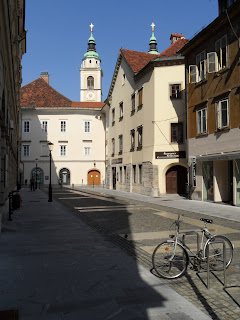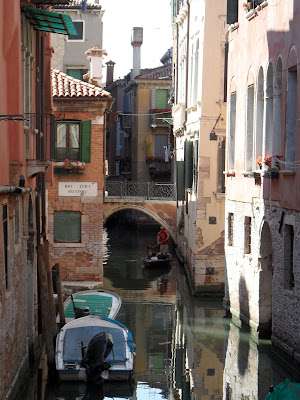 |
| The Soča: a rafter's paradise |
Travelling without a clear plan, enticing as it may seem, can be something of a nerve-racking experience. Especially when you're the kind of person who is meticulous about the simplest of things: taking care not to crack the spine when reading a book, paying each exhibit in a museum the attention it deserves, making a to-do list for things that don't really need a to-do list
. You get the idea.
What it comes down to is that I keep asking myself questions such as: how do I make sure that my objective itinerary through a particular country or region is, in fact, a route worth perspiring profusely for? Of course, I ask around, and there's always my not very detailed and thus not very helpful guidebook covering the entire Mediterranean. But at some point you have to make up your mind, turn left or right and just enjoy whatever the road serves you up.
Cycling in Slovenia, for that matter, is an almost therapeutic experience. This tiny speck on the map, wedged in between the Austrian Alps to the north, Italy to the west, and Hungary and Croatia to the east and south, is nothing short of sensational. Here, it doesn't matter whether you turn left or right, the country keeps shoving mind-blowing scenery in your face.
 |
| Lake Bohinj, less touristy than Lake Bled |
I entered Slovenia at Nova Gorica, which, together with its Italian counterpart Gorizia, makes up a decent-sized town. Still, having just winded my way through Gorizia's colourful streets, Nova Gorica strikes the unsuspecting first-time visitor as a bit of an afterthought. It is, as it turned out, hence the 'Nova' part in the name of the place. But that was something my host for the night had to point out.
Gorizia used to be the capital of the former Slovenian province of Goriška. When after WWII the Italians took control over the place, the new socialist regime in Yugoslavia thought it would make a nice statement to build a brand-new town right next to it on the eastern side of the border. According to my host, they drew up some pretty ambitious plans, only a small part of which was ever carried out. Today, grim apartment blocks loom large, interspersed with the odd casino. The entire local economy depends upon attracting short-stay visitors from Italy, where casinos are rather thin on the ground
—an opportunistic move that brought about the steady decline of a once-thriving cultural scene.
 |
| Madness in downtown Ljubljana |
From Nova Gorica I headed north along the banks of the Soča river (Isonzo in Italian), a major WWI front and the backdrop to Ernest Hemingway's
A Farewell to Arms. More of a gorge than a valley, I kept shaking my head in disbelief at the contrast with the drab Italian Po valley I had just left behind. At the village of Most na Soči I turned right, ready for a frolic in the Julian Alps. However, within minutes the fine drizzle I had been trying to ignore turned into a fully-fledged thunderstorm. Having enjoyed ridiculously good weather ever since my departure from Holland, I tried not to curse, got out my rain kit and pedalled on. Even through the rain-covered lenses of my cycling glasses I couldn't help being amazed by the beauty of it all. Dense forests, deserted country roads, a cluster of white houses huddled around a charming church. Soaked and knackered, I ended up staying in a mountain hut. Seven euros for the night, and for a bit more the owner was happy to chop some wood and light a fire so that I could enjoy a warm shower. Later that night, I had to make an effort not to fall asleep and land my face into a bowl of piping hot pasta.
I continued my tour of Slovenia with a visit to the mountain lakes of Bohinj and Bled, decided to take a break in Ljubljana, with its stamp-sized historical city centre, and rounded it all off with a quick peek into the Unesco-listed Škocjan caves. Nearing the Croatian border, I noticed that rather than looking forward to entering a new country I felt sorry to leave the one I had just visited. And so, awaiting my turn at the border checkpoint, it seemed only appropriate to softly repeat after the national tourist board: I feel sLOVEnia...














